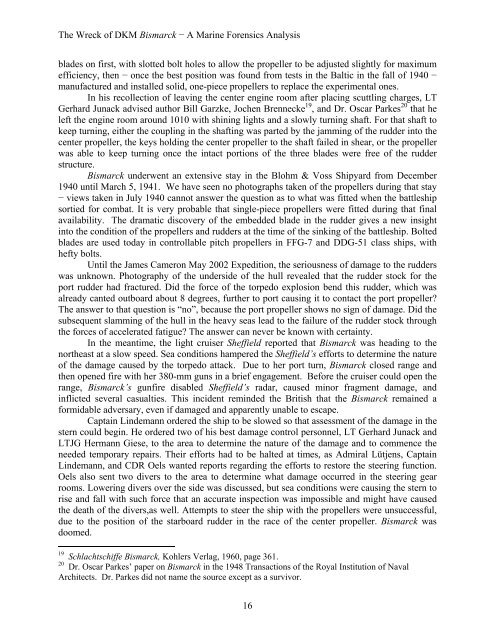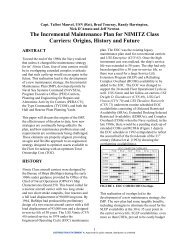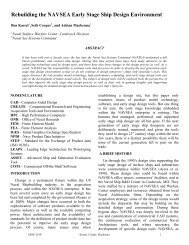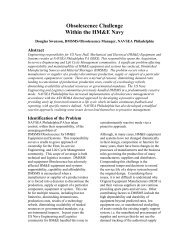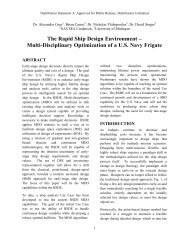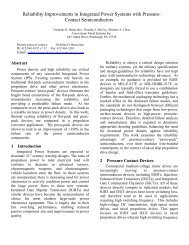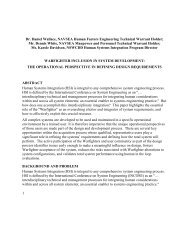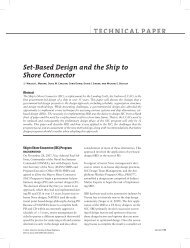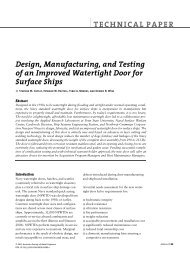The Wreck of DKM Bismarck − A Marine Forensics Analysis 1 The ...
The Wreck of DKM Bismarck − A Marine Forensics Analysis 1 The ...
The Wreck of DKM Bismarck − A Marine Forensics Analysis 1 The ...
Create successful ePaper yourself
Turn your PDF publications into a flip-book with our unique Google optimized e-Paper software.
<strong>The</strong> <strong>Wreck</strong> <strong>of</strong> <strong>DKM</strong> <strong>Bismarck</strong> <strong>−</strong> A <strong>Marine</strong> <strong>Forensics</strong> <strong>Analysis</strong><br />
blades on first, with slotted bolt holes to allow the propeller to be adjusted slightly for maximum<br />
efficiency, then <strong>−</strong> once the best position was found from tests in the Baltic in the fall <strong>of</strong> 1940 <strong>−</strong><br />
manufactured and installed solid, one-piece propellers to replace the experimental ones.<br />
In his recollection <strong>of</strong> leaving the center engine room after placing scuttling charges, LT<br />
Gerhard Junack advised author Bill Garzke, Jochen Brennecke 19 , and Dr. Oscar Parkes 20 that he<br />
left the engine room around 1010 with shining lights and a slowly turning shaft. For that shaft to<br />
keep turning, either the coupling in the shafting was parted by the jamming <strong>of</strong> the rudder into the<br />
center propeller, the keys holding the center propeller to the shaft failed in shear, or the propeller<br />
was able to keep turning once the intact portions <strong>of</strong> the three blades were free <strong>of</strong> the rudder<br />
structure.<br />
<strong>Bismarck</strong> underwent an extensive stay in the Blohm & Voss Shipyard from December<br />
1940 until March 5, 1941. We have seen no photographs taken <strong>of</strong> the propellers during that stay<br />
<strong>−</strong> views taken in July 1940 cannot answer the question as to what was fitted when the battleship<br />
sortied for combat. It is very probable that single-piece propellers were fitted during that final<br />
availability. <strong>The</strong> dramatic discovery <strong>of</strong> the embedded blade in the rudder gives a new insight<br />
into the condition <strong>of</strong> the propellers and rudders at the time <strong>of</strong> the sinking <strong>of</strong> the battleship. Bolted<br />
blades are used today in controllable pitch propellers in FFG-7 and DDG-51 class ships, with<br />
hefty bolts.<br />
Until the James Cameron May 2002 Expedition, the seriousness <strong>of</strong> damage to the rudders<br />
was unknown. Photography <strong>of</strong> the underside <strong>of</strong> the hull revealed that the rudder stock for the<br />
port rudder had fractured. Did the force <strong>of</strong> the torpedo explosion bend this rudder, which was<br />
already canted outboard about 8 degrees, further to port causing it to contact the port propeller?<br />
<strong>The</strong> answer to that question is “no”, because the port propeller shows no sign <strong>of</strong> damage. Did the<br />
subsequent slamming <strong>of</strong> the hull in the heavy seas lead to the failure <strong>of</strong> the rudder stock through<br />
the forces <strong>of</strong> accelerated fatigue? <strong>The</strong> answer can never be known with certainty.<br />
In the meantime, the light cruiser Sheffield reported that <strong>Bismarck</strong> was heading to the<br />
northeast at a slow speed. Sea conditions hampered the Sheffield’s efforts to determine the nature<br />
<strong>of</strong> the damage caused by the torpedo attack. Due to her port turn, <strong>Bismarck</strong> closed range and<br />
then opened fire with her 380-mm guns in a brief engagement. Before the cruiser could open the<br />
range, <strong>Bismarck</strong>’s gunfire disabled Sheffield’s radar, caused minor fragment damage, and<br />
inflicted several casualties. This incident reminded the British that the <strong>Bismarck</strong> remained a<br />
formidable adversary, even if damaged and apparently unable to escape.<br />
Captain Lindemann ordered the ship to be slowed so that assessment <strong>of</strong> the damage in the<br />
stern could begin. He ordered two <strong>of</strong> his best damage control personnel, LT Gerhard Junack and<br />
LTJG Hermann Giese, to the area to determine the nature <strong>of</strong> the damage and to commence the<br />
needed temporary repairs. <strong>The</strong>ir efforts had to be halted at times, as Admiral Lütjens, Captain<br />
Lindemann, and CDR Oels wanted reports regarding the efforts to restore the steering function.<br />
Oels also sent two divers to the area to determine what damage occurred in the steering gear<br />
rooms. Lowering divers over the side was discussed, but sea conditions were causing the stern to<br />
rise and fall with such force that an accurate inspection was impossible and might have caused<br />
the death <strong>of</strong> the divers,as well. Attempts to steer the ship with the propellers were unsuccessful,<br />
due to the position <strong>of</strong> the starboard rudder in the race <strong>of</strong> the center propeller. <strong>Bismarck</strong> was<br />
doomed.<br />
19 Schlachtschiffe <strong>Bismarck</strong>, Kohlers Verlag, 1960, page 361.<br />
20 Dr. Oscar Parkes’ paper on <strong>Bismarck</strong> in the 1948 Transactions <strong>of</strong> the Royal Institution <strong>of</strong> Naval<br />
Architects. Dr. Parkes did not name the source except as a survivor.<br />
16


